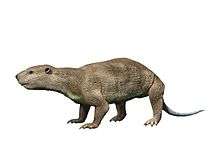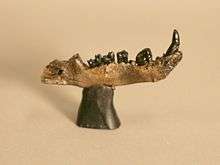Didelphodon
| Didelphodon Temporal range: Late Cretaceous,[1] 73–66 Ma | |
|---|---|
 | |
| The only known Lancian age mammal skeleton, this cast of Didelphodon is in the Rocky Mountain Dinosaur Resource Center in Woodland Park, CO and was collected in Harding County, SD. | |
| Scientific classification | |
| Kingdom: | Animalia |
| Phylum: | Chordata |
| Class: | Mammalia |
| Infraclass: | Metatheria |
| Family: | Stagodontidae |
| Genus: | Didelphodon Marsh, 1889 |
| Type species | |
| Didelphodon vorax Marsh, 1889 | |
| Species | |
|
Didelphodon vorax Marsh, 1889 | |
Didelphodon (meaning "two womb tooth") is a genus of stagodont metatherians from the Late Cretaceous of North America.[2]
Description

Although perhaps little larger than a Virginia opossum, it was a large mammal for Mesozoic standards. The teeth have specialized bladelike cusps and carnassial notches, indicating that the animal was a predator; the jaws are short and massive and bear enormous, bulbous premolar teeth which appear to have been used for crushing.[3]
A recently found specimen, located just 40 m (130 ft) away from a Triceratops in a riverbed, shows the anatomy of Didelphodon. Before the find, only a lower jaw and a partial skull were assigned to the species. This new find shows that Didelphodon possessed an otter-like body with a tasmanian devil-like skull. A study that is being prepared by Kraig Derstler, Greg Wilson, Robert Bakker, Ray Vodden and Mike Triebold will describe this new specimen, housed in the Rocky Mountain Dinosaur Resource Center.[2]

Paleobiology

Fossil evidence suggests Didelphodon was a small aquatic predator, perhaps filling the niche that otters do today. A specimen of this stagadont was found to have a skeleton similar to that of an otter yet it had strong jaws suggesting it mostly fed on molluscs. Post-cranial anatomy is strongly convergent with modern sea otters, implying a primarily aquatic existence.[1] [3] Some convergence with the carnassials of other predatory mammal groups has also been noted.[4]
Discovery

Three species are known: Didelphodon vorax, D. padanicus, and D. coyi.[3] A specimen was discovered in 2001, Harding County, South Dakota.[2] Didelphodon is known from the Hell Creek Formation of Montana, the Lance Formation of Wyoming, and the Scollard Formation of Alberta, where it is one of the most abundant mammals.[3]
Classification
Didelphodon is a stagodontid marsupial related to Eodelphis and Pariadens. The genus appears to descend from the Campanian Eodelphis, and in particular appears to be related to Eodelphis cutleri. Pariadens appears to be more primitive than either Eodelphis or Didelphodon, and is probably sister to their group. Didelphimorphia is an order that was named in 1872 by Gill. Previously, in 1821, Gray named the superfamily Didelphoidea to house the families Alphadontidae, Pediomyidae, Peradectidae, and Stagodontidae, which unites Didelphodon with many other genera.[3]
In 2006, a study found only two stagodontids, Didelphodon and Eodelphis. The previously included Pariadens was excluded from the group because its type species, P. kirklandi, lacks any of the families characteristics, so it is classified as Marsupialia incertae sedis. Another species, "P." mckennai even lacks marsupial features and is probably a therian. Another historical stagodontid, Boreodon, which is a nomen dubium. A last final purported stagodontid was Delphodon, which is probably a synonym of Pediomys or Alphadon.[1]
References
- 1 2 3 Fox, R.C.; Naylor, B.G. (2006). "Stagodontid marsupials from the Late Cretaceous of Canada and their systematic and functional implications" (PDF). Acta Palaeontologica Polonica. 51 (6): 13–36.
- 1 2 3 "Didelphodon vorax". Rocky Mountain Dinosaur Resource Center. 2010-12-07.
- 1 2 3 4 5 Kielan-Jaworowska, Z.; Cifelli, R.L.; Cifelli, R; Luo, Z.X. (2004). Mammals from the Age of Dinosaurs: Origins, Evolution and Structure. New York: Columbia University Press. pp. 441–462.
- ↑ CHRISTIAN DE MUIZON and BRIGITTE LANGE-BADRÉ, Carnivorous dental adaptations in tribosphenic mammals and phylogenetic reconstruction, Article first published online: 29 MAR 2007 DOI: 10.1111/j.1502-3931.1997.tb00481
Further reading
- Clemens, W. A., Jr. (1979). Marsupialia. Mesozoic mammals: the first two-thirds of mammalian history. J. A. Lilligraven, Kielan-Jaworowska and W. A. Clemens, Jr. Berkeley, University of California Press: 192-220.
- Fox, R. C., & Naylor, B. G. (1986). A new species of Didelphodon Marsh (Marsupialia) from the Upper Cretaceous of Alberta, Canada: paleobiology and phylogeny. Neues Jahrbuch für Geologie und Paläontologie Abhandlungen, 172, 357-380.
- BBC Online: Science & Nature: Prehistoric Life